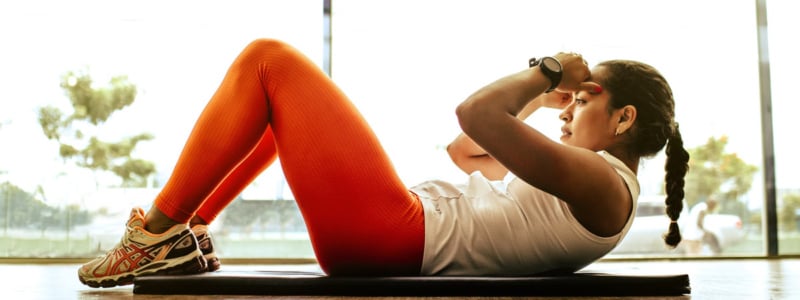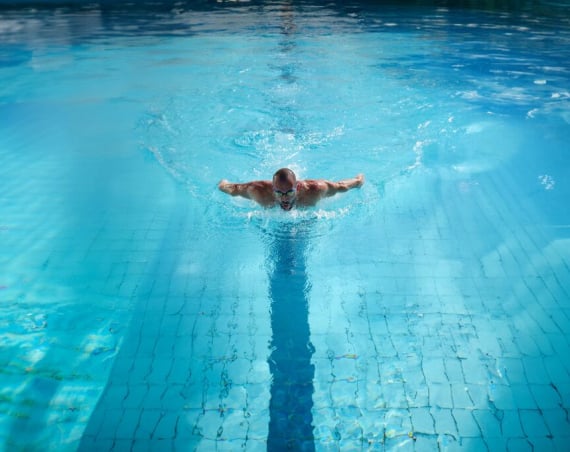Balance, posture, and stability all start with your core. A strong torso is the foundation of almost every type of body movement. Runners tone abdominals, obliques, and glutes to help them stay in their stride. Yoga enthusiasts know it’s a must to assume and hold many different poses. Core training can even help alleviate backaches and pain.
If you’re looking to include more abdominal exercise in your routine, there are plenty of ways to do it. In fact, most core exercises don’t even require equipment — just space, a mat, and you. Whether you’re a beginner or an expert, these are our top exercises to boost your core and abs.
What exactly are you exercising in a core workout? Your core is a group of muscles supporting your spine, hips and pelvis, stomach, back, and bum. So, when people talk about “six-pack abs” (your rectus abdominis), that’s only one of many muscles in your torso. The best core workouts engage multiple muscle groups in your torso, chest, back, and glutes.
Key takeaways
In a hurry? Here are the essentials.
- A strong core underpins balance, posture and stability, powering everyday movement as well as athletic performance.
- Core training works more than just abs — it recruits back muscles, glutes, hip flexors and even the pelvic floor.
- Beginners can start safely with bridges, dead bugs and planks to lay solid foundations.
- Bird dogs, bicycle crunches and mountain climbers introduce more movement and test coordination.
- Advanced moves like hand walkouts and V-sits take strength and stability up a notch.
- Consistency and good form protect against injury, improve posture and enhance other workouts.
- Mixing up exercises ensures every part of the core is strengthened for balance and effectiveness.
- Adding kit like medicine balls or TRX straps can raise intensity and results.
- A personal trainer can tailor exercises to your level and goals for the best outcomes.
Beginner core exercises
Bridge
Bridge is a core classic, also strengthening your glutes and hamstring muscles. First, lie down on your back with your knees bent and feet flat on the floor. Engaging your abdominal muscles, slowly lift your hips away from the floor. Your hips, knees, and shoulders should align to form a straight line. Hold this position for three deep breaths and then gently lower to the floor.
Dead bug
Don’t worry, there are no creepy-crawlies here! The dead bug is a great core exercise for stabilising the abs, hips and lower back using contra-lateral limb movement (that’s coordinating opposite limbs at the same time).
Lie on your back and extend your arms straight towards the sky. Lift your knees up and bent at a 90-degree angle. Keeping your right knee and left arm in place, slowly drop your left knee and right arm toward the ground in a straight line and then return to the starting position. Repeat on the other side and you’ve done one rep of the dead bug.
Plank
You probably already know what a plank is, but did you know there are variations for beginners and experts? For a basic plank, start on your stomach with your forearms flat. Keeping your elbows and shoulders aligned, draw your body up using your core while keeping the torso straight, like a push-up. If you need to make it a little easier, start with your knees down. What if you want a challenge? After progressing to a straight-arm plank (rather than resting on your forearms), add in movement such as reaching your hand to tap the opposite shoulder, then repeating in the other direction. It might feel like you’re doing the Macarena, but variations like these are perfect for a tight and stable core.
Supine toe tap
Supine toe taps are another way to target multiple muscles like abdominals, hips, and obliques in one series of movements. Start by lying on your back. Align your knees above your hips, bent at a 90-degree angle. One leg at a time, lower and tap your pointed toe to the floor, then draw it back up. Repeat with another leg to complete the sequence.
Intermediate core exercises
Bird dog
Bird dogs use your body weight to strengthen your lower back, glutes, abdominals, and thighs and are excellent for testing balance and coordination. To get started, kneel on a mat with your hands pressed into the ground shoulder-width apart. Extend one arm straight ahead and extend the opposite foot back, like you’re pushing your foot flat against an imaginary wall. Engage your abs to hold a straight line through the whole extension, from your fingertips to your feet. Repeat on your other side to complete the rep.
Bicycle crunch
Bicycle crunches are a deep core exercise, targeting both lower abdominals and side abdominals. Lie comfortably on the floor with your back flat, hands behind your head, and knees above hips bent at a 90-degree angle. Lift your head and shoulder blades from the floor as you extend your left leg forward. Then use your torso to twist your left elbow towards your right knee. Release and do the same movement for the opposite side to finish one bicycle crunch.
Mountain climber
The mountain climber is a step up from a standard plank, using dynamic movement to create a full-body workout that combines strength and cardio. Start in a straight-arm plank, bracing with your abdominals and placing your hands slightly wider than your shoulders. From this planking position, march in place by drawing one knee at a time up towards your chest. As you move, mind your form and keep your back straight. You can move at a steady pace for endurance, or go faster to test your agility.
Advanced core exercises
Hand walkout
If you’ve practised yoga, hand walkouts look like the classic downward dog mixed with a plank. Hand walkouts tone core muscles, test balance, and push your strength — making it an advanced move.
Start by standing and then bend forward. Bend your knees generously, don’t lock them, so you can place your hands on the ground near your toes. This is where the “walkout” comes in. Step your hands gradually until you reach a straight-arm plank position. As you move, try to keep your hips and shoulders in alignment, which will engage your core. Then step your hands back to where you started to complete the walkout.
V-sit
Similar to a boat pose in yoga, a v-sit challenges a whole host of different core muscles. Make sure your core is pulled in, then from a seated position, extend your legs at 45-degree angle. Lean your torso back – stop if you feel any strain in your lower back – so you’re in a v-shape. You can keep your hands on the ground to start; to make it harder, extend your arms forward.
More ways to strengthen your core
You can always enhance your core workouts with specialised equipment at your local David Lloyd gym. Grab a medicine ball for an extra test of strength during your routine, or try out a few reps of TRX crunches using strap resistance equipment. If you need some extra guidance, our Personal Trainers can help you meet your goals.
At the end of the day, core exercise isn’t just about six-packs — core work supports your overall wellbeing. Incorporating core exercises into your routine at home or at the gym will serve you well.
Still not sure where to start? Whether you’re returning to exercise or looking for a new challenge, simply find your closest David Lloyd Club and discover new ways to reach your fitness goals.
Find a club




